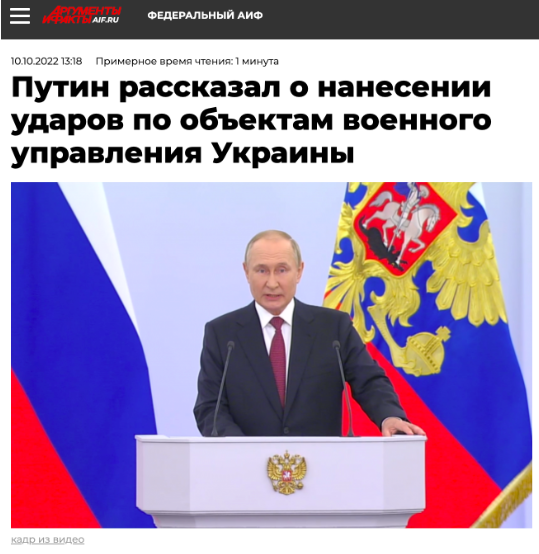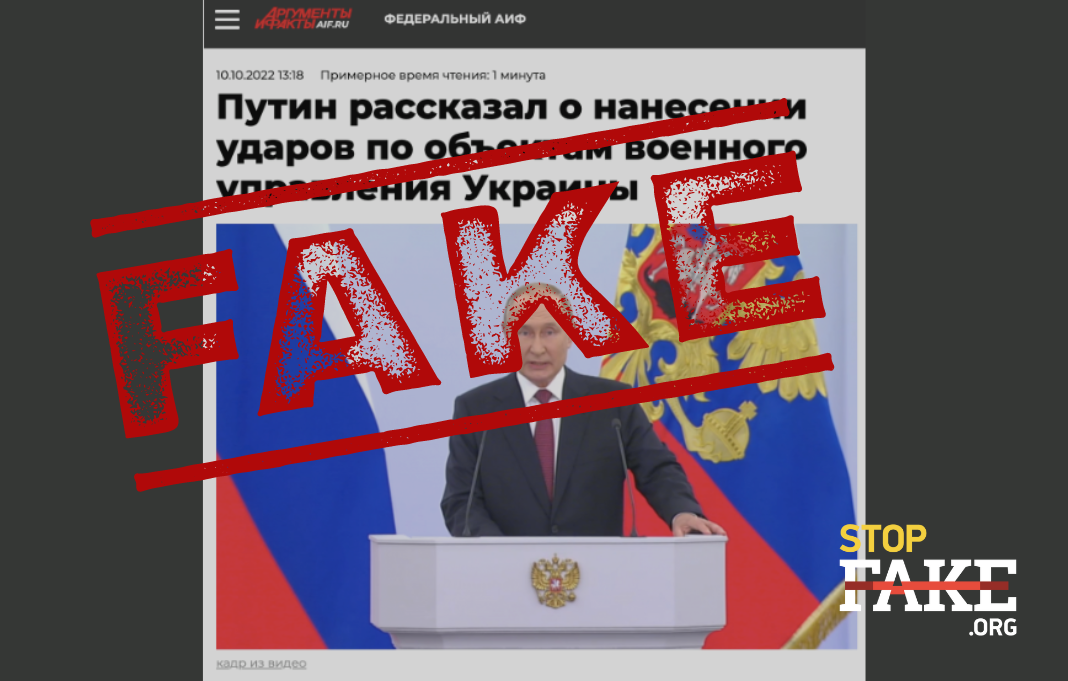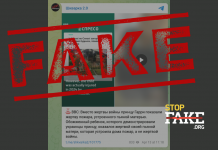According to Ukrainian and foreign intelligence, Russia was planning these latest massive missile strikes against Ukraine even before the illegally constructed bridge over the Kerch Strait was damaged. On October 10, Russia attacked civilian infrastructure, not Ukrainian military facilities. Russian missile strikes killed and injured dozens of Ukrainian civilians.
Following Russia’s massive missile attack on civilian targets in a number of Ukrainian cities on October 10, pro-Kremlin media began spreading disinformation about “the high accuracy of the strikes on Ukraine’s military infrastructure“. Citing the Russian president, Kremlin media stated that Ukraine itself was to blame for the massive attack on civilian objects. Quoting Putin, propagandists announced that the missile strikes on Ukraine were “Russia’s response to the terrorist attack” – refering to the October 8 explosion on the illegally built Russian bridge over the Kerch Strait.

On the morning of October 10, Russia dropped dozens of missiles and kamikaze drones on Ukrainian cities. The occupiers used 84 cruise missiles and 24 unmanned aerial vehicles, including Iran’s Shahed-136 kamikaze drones, to strike critical Ukrainian infrastructure. Ukrainian forces disarmed more than half of the missiles fired, destroying a total of 56.
The Kremlin asserts that Ukraine is to blame for the massive strike, as it is supposedly a “response” to the Oct. 8 explosion on the Kerch Strait bridge. However, information from Ukrainian intelligence disproves Putin’s statement. According to Ukraine’s Main Intelligence Directorate, Russia began preparing this attack as early as the first days of October, even before the explosion on the illegally built bridge. The Directorate stressed that on October 2-3, Russian military strategic and long-range aviation units received orders to prepare for massive strikes against Ukraine. The targets were critical civilian infrastructure and densely populated Ukrainian city centers.
On October 11, U.S. National Security Council Coordinator for Strategic Communications John Kirby confirmed this information, stressing that Russia had indeed been preparing a massive missile attack on Ukrainian cities for a long time. Just like on February 24, 2022, when Russia launched a full-scale invasion of Ukraine, Putin did not need a “reason” to start bombing Ukrainian cities.
According to Ukrainian State Emergency Service preliminary reports, Russian attacks on civilian facilities in Ukraine on October 11 killed 19 people and injured 105. The strikes on critical and civilian infrastructure temporarily left some 4,000 towns throughout Ukraine without power. By the morning of October 11, 301 towns and villages in the Kyiv, Lviv, Sumy, Ternopil, and Khmelnytskyi regions had lost power.
For five hours on October 10, Russia continued a series of strikes against the most crowded places in Ukrainian cities. One missile hit a busy crossroads in the Kyiv city center during rush hour as people were driving to work. Another missile hit a pedestrian bridge in the capital’s center. Missiles also struck children’s playgrounds, apartment buildings and schools, as well as foreign diplomatic facilities in Kyiv, said Oleh Nikolenko, spokesman for the Ukrainian Foreign Ministry. One of the missiles damaged the visa office of the German Embassy in Ukraine, another damaged the EU Advisory Mission staff building.
In total, on October 10 alone, some 70 buildings were damaged in Kyiv. As a result of the Russian missile strike on Lviv, about 90% of the city was temporarily left without power. In Dnipro, Russian attacks targeted critical infrastructure, residential buildings, and transport hubs.
These strikes were carried out when Ukrainians were on their way to work. None of the aforementioned facilities have anything to do with military infrastructure, as the Russian media assure us, but these places are always crowded. Commenting on its bloody attack, Russia said it was “satisfied with the result”, the strikes had “achieved their stated goals” of killing Ukrainian civilians.
Russia’s inhumane strikes against civilian targets in Ukraine drew sharp criticism and shock from various countries and international organizations. U.S. President Joe Biden called the Russian attack on civilians a brutal and illegal attack on non-military targets. EU High Representative for Foreign Affairs and Security Policy Josep Borrell stressed that attacks on civilians have no place in the 21st century. European Council President Charles Michel said the Kremlin’s indiscriminate attacks demonstrate its desperation and called for Russia to be held accountable.
According to the UN High Commissioner for Human Rights Spokesperson Ravina Shamdasani, Russia’s October 10-11 missile attacks on Ukrainian tourist places, offices and busy crossroads could be considered a war crime. In a joint statement, the presidents of 11 European countries also emphasized that these latest Russian missile attacks were a war crime that had no statute of limitations and were subject to the jurisdiction of courts around the world.
On October 10 the 11th UN emergency special session on Ukraine resumed its work in New York. Delegates gathered to discuss a draft resolution condemning the so-called “referendums” Russia illegally held in the occupied territories of Ukraine. However, the discussion was overshadowed by the bloody Russian attacks on Ukrainian cities: of the countries that spoke during the meeting, all but Russia condemned the barbaric Russian strikes. A number of delegations also stressed that the Kremlin’s attacks could be considered war crimes.
On the morning of October 11, Russia continued its attacks on civilian targets in Ukraine with 28 cruise missiles and Iranian drones. Ukraine disarmed 20 missiles and destroyed 13 drones.





